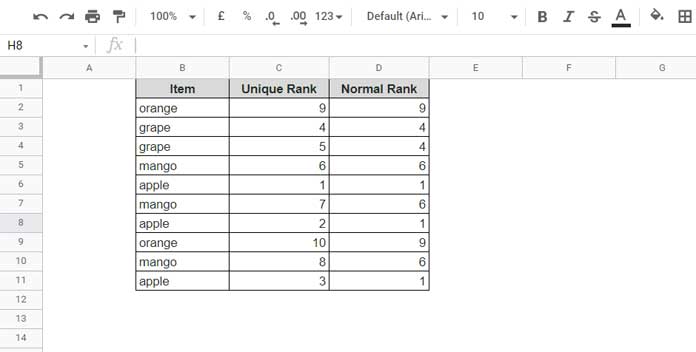Using a combination of two conditional count functions, we can rank text values uniquely in Google Sheets. They are Countif and Countifs.
Earlier I have shared a formula to rank data alphabetically. We can’t use the same here as that will give the same rank to duplicate texts.
For example, if “apple” repeats twice and the rank of apple is 1 in the list, both will get the rank 1.
When we rank text values uniquely without duplicates, the first “apple” will get rank # 1, and the second “apple” will get rank # 2. It will affect the ranking of other text values in the list.
Before going to the formula part, one more thing.
You may have a list that is sorted or unsorted. My formula will work smoothly in both scenarios.
Please pay attention to column C in the following two tables.
Unsorted (Randomized) List:

Sorted List:

Unique Rank of Texts
Generic Formula:
Unique Rank of Text = Count_of_Text_Below + Running_Count_of_Text
Arguments:
Count_of_Text_Below – The number of texts < (less than) the text in question. To understand it, let’s consider the above-sorted list.
The cells B2, B3, and B4 contain “apple.” There is no text less than it. So the count of text below will be 0 (zero) each.
What about the count of “grape” in cells B5 and B6. It will be three each as there are three items (apples) less than it below.
Running_Count_of_Text – In the sorted list, the running count of “apple” in cells B2, B3, and B4 will be 1, 2, and 3, respectively.
What about the running count of “grape” in cells B5 and B6. It will be 1 and 2, respectively.
Based on the above, we can rank texts uniquely as below in Google Sheets.
| Item | Count_of_Text_Below | Running_Count_of_Text | Unique Rank of Text |
| apple | 0 | 1 | 1 |
| apple | 0 | 2 | 2 |
| apple | 0 | 3 | 3 |
| grape | 3 | 1 | 4 |
| grape | 3 | 2 | 5 |
Note:- I have only picked part of the items from the sorted list for the explanation.
Formulas to Rank Text Values Uniquely in Google Sheets
We will start with a drag-down formula.
Here is the formula to return the rank of text values uniquely in Google Sheets. Insert it in cell C2 and copy-paste it down as far as needed.
=COUNTIF($B$2:$B,"<"&B2)+COUNTIF($B$2:B2,B2)Count_of_Text_Below = COUNTIF($B$2:$B,"<"&B2)
Running_Count_of_Text = COUNTIF($B$2:B2,B2)
It will work correctly even if the list is unsorted.
Can we use an array formula here?
Yes. Here we can use two count functions. They are COUNTIF and COUNTIFS.
You May Like: How to Use All Google Sheets Count Functions [All 8 Count Functions]
First of all, empty C2:C. Then insert the following array formula in cell C2 to rank texts uniquely.
=ArrayFormula(
if(B2:B="",,
COUNTIF(B2:B,"<"&B2:B)+
COUNTIFS(B2:B,B2:B,row(B2:B),"<="&ROW(B2:B))
)
)Count_of_Text_Below – COUNTIF(B2:B,"<"&B2:B)
Running_Count_of_Text – COUNTIFS(B2:B,B2:B,row(B2:B),"<="&ROW(B2:B))
The formula if(B2:B="",, is to limit the output in non-blank rows.
That’s all. This way, you can rank text uniquely without duplicates in Google Sheets.
Thanks for the stay. Enjoy!
Resources
- How to Rank without Ties in Google Sheets.
- Top 10 Ranking without Duplicate Names in Google Sheets.
- Flexible Array Formula to Rank Without Duplicates in Google Sheets.
- How to Find Rank of a Non Existing Number in an Existing Data Range.
- Compare and Highlight Up and Down in Ranking in Google Sheets.
- Find the Rank of an Item in Each Column in Google Sheets.
- Highlight Top 10 Ranks in Single or Each Column in Google Sheets.
- How to Rank Group Wise in Google Sheets in Sorted or Unsorted Group.





















